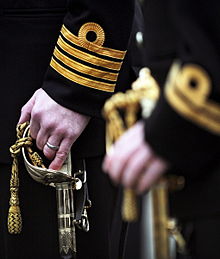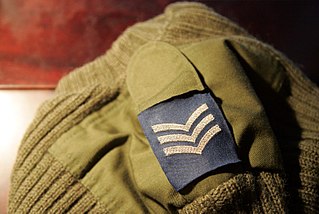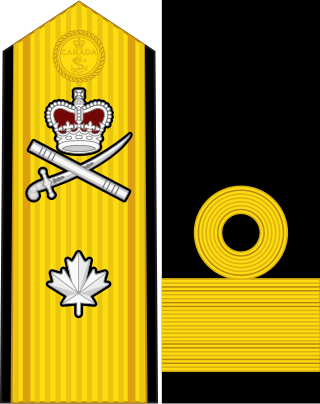This article needs additional citations for verification .(November 2015) |

The executive curl, or the "Elliot's Eye", is the name given to the ring above a naval officer's gold lace or braid insignia. It originated with the Royal Navy.
This article needs additional citations for verification .(November 2015) |

The executive curl, or the "Elliot's Eye", is the name given to the ring above a naval officer's gold lace or braid insignia. It originated with the Royal Navy.
The precise origin of "Elliot's eye" is somewhat of a mystery. One story is that it is in memory of Captain George Elliot, who, when wounded in the arm in the Crimean War, used the gold on his sleeve as a sling. There are also theories that the Elliott’s eye refers to the method of making an eye in a hemp cable and is said to have been introduced into the Service by the Honourable William Elliot, a member of the Board of Admiralty in 1800 and 1801. It may perhaps best be explained as the simplest-possible form of the various loops, trefoils, Austrian knots and Hungarian knots that were popular embellishments on Service uniforms at the time.
Lord Anson's Board of Admiralty issued the first uniform regulations in 1748 to set a distinction between naval and other officers and lay down precise rules of rank and precedence among naval officers. Distinctive lace on the sleeves of flag officers was introduced in 1783 and was extended to other officers in 1856 with the addition of the curl in the uppermost row of lace for officers of the executive branch only. From 1879 to 1891, Royal Navy officers wore three brass buttons between the lace. In January 1915, the use of the curl was extended to engineer officers and to other officers in 1918. The naval pattern lace was different in that it followed a straight line with a round loop while British Army uniforms were decorated on the sleeve with a loop that rose to a peak in the form of a “crow’s foot” or “Austrian knot”.
When the Royal Naval Reserve was formed in 1859, its officers were differentiated from regular officers with rank braid that was half the width and formed two waved lines, one superimposed upon the other with a six-pointed star in place of the curl.
In 1903, the Royal Naval Volunteer Reserve was instituted and the officers were distinguished with waved stripes worn parallel to each other, surmounted by a squared waved “curl”.
Officers of the Women’s Royal Naval Service wore sky-blue lace with a diamond-shaped loop. The Royal Fleet Auxiliary also employs a diamond in lieu of the curl.
Although in the Royal Navy the curl is now common to all officers (less those of its associated cadet forces), some other navies who copied the custom have restricted its use to their deck officers. While some navies placed insignia above the braid to indicate specialist branches, Commonwealth navies used coloured cloth beneath the gold lace. Coloured branch distinction, first introduced in 1863, went out of use except for the medical, nursing, medical administration and technical branches, on 31 December 1959.
Although 19 of 22 Commonwealth of Nations navies use the executive curl, according to Jane's Fighting Ships , 55 of the world's navies use the insignia on officer’s uniform in their naval forces; Argentina, Australia, Bahamas, Bangladesh, Barbados, Belgium, Brazil, Brunei, Canada, Colombia, Congo (DRC), Cyprus, Denmark, Estonia, Fiji, Gabon, Ghana, Greece, Iceland, India, Iran, Italy, Jamaica, Kenya, Latvia, Lithuania, Malaysia, Mauritania, Mexico, Myanmar, Morocco, Mozambique, Netherlands, New Zealand, Nigeria, Norway, Pakistan, Papua New Guinea, Panama, Poland, Portugal, Qatar, Romania, Slovenia, South Africa, Spain (except during the 1931-1939 Spanish Republic), Sri Lanka, Sweden, Thailand, Tonga, Trinidad and Tobago, Tunisia, Turkey, United Kingdom, Uruguay, Venezuela and Vietnam.
The navies that do not use the curl may replace it with a star, as in the cases of the Chilean Navy, the German Navy, the Russian Navy, the United States Navy, and winter uniforms of the Chinese Navy and the Indonesian Navy; or with other devices, as in the cases of the Finnish Navy, the Japan Maritime Self-Defense Force, the Republic of Korea Navy and shoulder boards of the French Navy.
Prior to 1910, the Royal Navy provided maritime defence of British North America and for the Dominion of Canada from 1867. In the early 20th century, Britain redistributed the British fleet and reduced its stations in Halifax and Esquimalt. As a result, the government of Canada on May 4, 1910, under the authority of the Naval Services Act, created the Naval Service of Canada. On August 29, 1911, it was designated the Royal Canadian Navy by King George V until 1968 when Canada’s navy became Maritime Command within the Canadian Armed Forces.
When it was created in 1910, it was natural for the emerging Canadian Navy to adopt the same unwavering rings with the executive curl for the permanent navy and subsequently the “wavy” shaped rings for the Royal Canadian Naval Volunteer Reserve (RCNVR) and the rings of narrow interwoven gold lace for the Royal Canadian Navy Reserve. Sea Cadet Corps officers had a small anchor in place of the executive curl.
Following World War II, the Royal Canadian Navy was reorganized with a single reserve component. In 1946, the distinctive wavy gold braid of the reserves gave way to the straight braided executive curl of the regular force until 1968. With the integration of the Canadian Armed Forces, unembellished straight braid became the common rank insignia for all officers of both the regular and reserve forces. The executive curl rank insignia was reserved for navy mess dress from 1968 to 2010 and used historical, rather than standard, rank structures, having both acting sub-lieutenants and sub-lieutenants wear one single bar of rank on the sleeve with the executive curl.
On March 5, 2010, the House of Commons unanimously passed a private members' motion recommending, "That the government should consider reinstating the navy executive curl on its uniforms." Guy Lauzon, member of Parliament for Stormont-Dundas-South Glengarry, explained that the insignia is common to most nations that have a monarch as a head of state. Subsequently, in recognition of the Canadian Naval Centennial, The Honourable Peter MacKay, Minister of National Defence, authorized the use of the executive curl for the Canadian Navy on Battle of Atlantic Sunday, May 2, 2010. After 42 years absence, the executive curl insignia became effective again for service dress uniforms on June 11, 2010, on the occasion of the Pacific Canadian Naval Centennial International Fleet Review parade of nations in Victoria, British Columbia. [1]
Rear admiral is a flag officer rank used by English-speaking navies. In most European navies, the equivalent rank is called counter admiral.
This is a table of the ranks and insignia of the Canadian Armed Forces. As the Canadian Armed Forces is officially bilingual, the French language ranks are presented following the English.
Officer Cadet is a rank held by military cadets during their training to become commissioned officers. In the United Kingdom, the rank is also used by members of University Royal Naval Units, University Officer Training Corps and University Air Squadron; however, these are not trainee officers with many not choosing a career in the armed forces.

Mess dress uniform is the most formal type of evening-wear uniform used by military personnel, police personnel, and other uniformed services members. It frequently consists of a mess jacket, trousers, white dress shirt and a black bow tie, along with orders and medals insignia. Design may depend on regiment or service branch, e.g. army, navy, air force, marines, etc. In modern Western dress codes, mess dress uniform is the supplementary alternative equivalent to the civilian black tie for evening wear. Mess dress uniforms are typically less formal than full dress uniform, but more formal than service dress uniform.
A flag officer is a commissioned officer in a nation's armed forces senior enough to be entitled to fly a flag to mark the position from which the officer exercises command.
Korvettenkapitän is the lowest ranking senior officer in a number of Germanic-speaking navies.
Subordinate officer is a term used in some armed forces for a grade of officer above a non-commissioned officer but still not actually commissioned, usually still in training. Such officers are treated for most intents and purposes as commissioned officers.

The Ranks of the Imperial Japanese Navy were the rank insignia of the Imperial Japanese Navy, used from its creation in 1868, until its dissolution in 1945 following the Surrender of Japan in World War II. The ranks were inspired by the ranks of the Royal Navy.
The officer ranks of the Royal Air Force, as they are today, were introduced in 1919. Prior to that Army ranks were used.
Before Unification as the Canadian Armed Forces in 1968, the Canadian military had three distinct services: the Royal Canadian Navy, the Royal Canadian Air Force, and the Canadian Army. All three services had a Regular (full-time) component and a reserve (part-time) component. The rank structure for these services were based on the services of the British military, the Royal Navy, the Royal Air Force, and the British Army. The change to a "Canadian" rank structure meant that many of the traditional (British) rank titles and insignia were removed or changed.

These are the official Royal Navy Officer ranks ordered by rank. These ranks are part of the NATO/United Kingdom ranks, including modern and past. Past insignia is in italic.

A shoulder mark, also called rank slide, or slip-on, is a flat cloth sleeve worn on the shoulder strap of a uniform. It may bear rank or other insignia. A shoulder mark should not be confused with a shoulder board, shoulder knot or epaulette, although these terms are often used interchangeably.

Captain (Capt) is a senior officer rank of the Royal Navy. It ranks above commander and below commodore and has a NATO ranking code of OF-5. The rank is equivalent to a colonel in the British Army and Royal Marines, and to a group captain in the Royal Air Force. There are similarly named equivalent ranks in the navies of many other countries.
The rank of admiral in Canada is typically held by only one officer whose position is Chief of the Defence Staff and the senior uniformed officer of the Canadian Forces. It is equivalent to the army and air force rank of general.

Commodore is a Canadian Forces rank used by commissioned officers of the Royal Canadian Navy. Brigadier-general is the equivalent rank in the Canadian Army and Royal Canadian Air Force.
In the Royal Canadian Navy, the rank of lieutenant-commander (LCdr) is the naval rank equal to major in the army or air force and is the first rank of senior officer. Lieutenant-commanders are senior to lieutenants (N) and to army and air force captains, and are junior to commanders and lieutenant colonels.
The rank insignia of the federal armed forces of the Federal Republic of Germany indicate rank and branch of service in the German Army, German Air Force, or the German Navy.
Lieutenant (abbreviated Lt, LT (U.S.), LT(USN), Lieut and LEUT, depending on nation) is a commissioned officer rank in many English-speaking nations' navies and coast guards. It is typically the most senior of junior officer ranks. In most navies, the rank's insignia may consist of two medium gold braid stripes, the uppermost stripe featuring an executive curl in many Commonwealth of Nations; or three stripes of equal or unequal width.
In the Royal Canadian Navy, the rank of lieutenant(N) (Lt(N)) (French: Lieutenant de vaisseau) is the naval rank equal to captain in the army or air force. When the naval rank lieutenant is written or typed, it is followed by the letter N to indicate that it is a naval rank to distinguish it from army and air force lieutenants (and therefore, the (N) remains silent as it must not be pronounced or replaced by the word (Navy)). Lieutenants(N) are senior to sub-lieutenants and to army and air force lieutenants, and are junior to lieutenant-commanders and majors.
Individual rank insignia to the (Army) ground forces and (Navy) naval forces (1935–1940) were established by orders 2590 and 2591, effective from September 22, 1935.